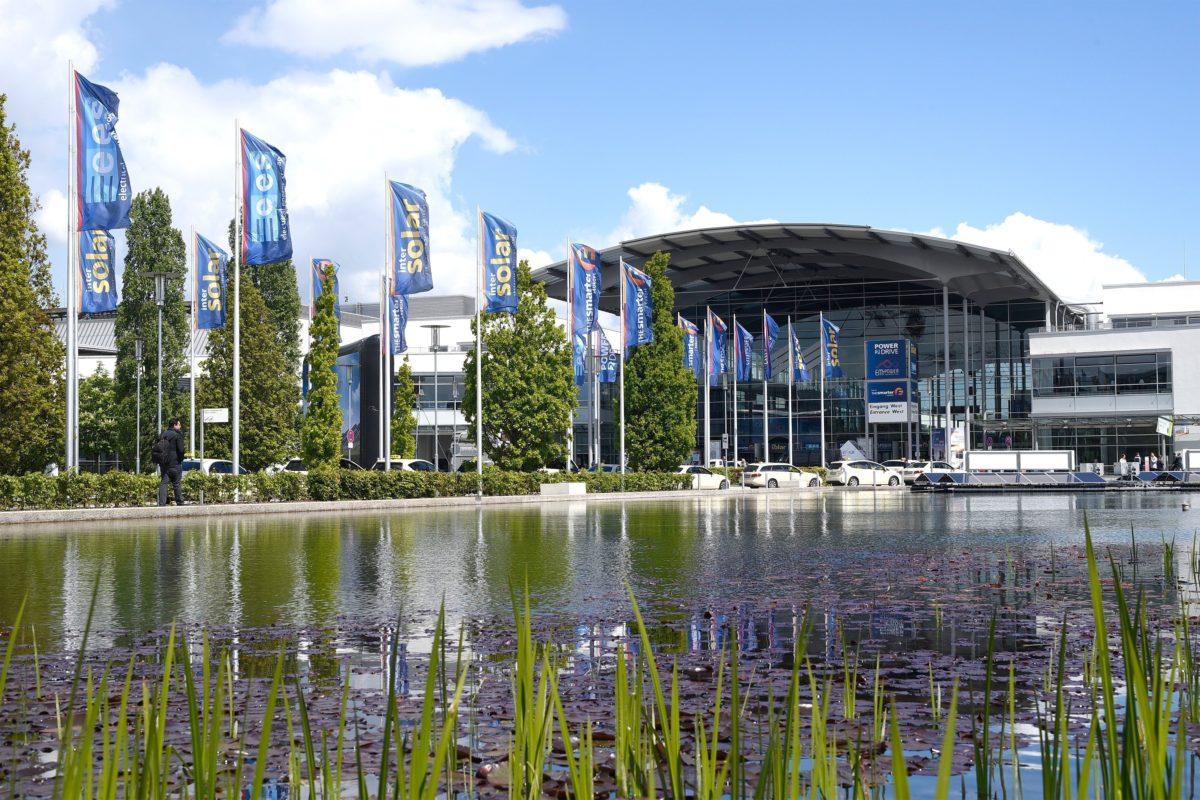
Standing room only at pv mag roundtable
Judging by the turnout at this afternoon’s pv magazine quality roundtable, we may have to find a bigger venue next year (and hopefully one with a reliable wifi signal).
Industry representatives were standing at the back wall for the popular event, and not just because the canapes were nearby.
An opening discussion of the merits of glass-glass modules versus backsheet products morphed into a panel debate about whether frameless double glass panels are an attractive option after Longi Solar Europe chief engineer Winfried Wahl spelt out his unequivocal opposition to the idea.
There was harmony among the panel on stage at that point but the same couldn’t be said of a discussion of the merits and demerits of testing modules to two or three times the rigors demanded by IEC standards. If I point out Paul Grunow, of testing company PI Berlin, and backsheet manufacturer DuPont’s Lucie Garreau-Iles were the panel members who indulged in an entertaining to and fro on that topic, you can probably guess who was arguing for what.
Grunow, though, did have the grace to concede that although he opted for double glass panels on his house he would consider DuPont backsheet modules “dependent on price”.
After Karl-Anders Weiss, of Fraunhofer ISE, bemoaned the fact bill of materials components were changing faster than the institute could test them, a second panel prompted similarly uncompromising views on whether cables should be directly buried or encased in pipes or ducts.
“I have a big problem with pipes, sand is better,” said Christian Bieber, of Solartechnik-Bayern, laying his cards squarely on the table.
With the occurrence of water in pipes – usually five to seven years after they have been laid amid claims about their superior durability – evidently the main concern for developers, a question from the floor about about similar worries associated with floating PV projects prompted pv magazine moderator Michael Fuhs to move things swiftly onto the final panel discussion.
With inverters this time under consideration, Michael Mills-Price demanded more rigorous pre-shipment testing for such vital parts of any PV project.
“You’ve discussed cable testing but inverters are way more complicated,” said the head of the inverter and energy storage business at testing company PVEL. “And you can ask the crowd here: What do you have more project downtime from, cable problems or inverter problems? Even with modules, what do you lose more time to: modular problems or inverter problems?”
The session closed with the results of a snap poll carried out by pv magazine in advance among the event attendees. Presented with a question and a set number of fixed responses, some 35% of respondents said their biggest concern in terms of module quality risk was the financial stability of the panel manufacturer. A further 32.5% highlighted glass breakage or manufacturing and 25% LID or LeTID degradation.

When Europe's nuclear goes solar
pv magazine managing editor Erica Johnson met with Lars Josten, CEO of Pfalzsolar, the sponsor of pv magazine live, to discuss the company’s latest news and how things are unfolding at Intersolar Europe.
pv magazine: Good afternoon Lars. Tell us about your latest project news announcement.
Lars Josten: I am excited to announce that we have won a 21 MW installation. Again in the Netherlands, but this time it seems like a game changer. It will be on sit of the only nuclear power plant location in the Netherlands. They decided instead they will build a solar plant.
Great to hear. What is the timeline of the project?
It will be constructed by the end of this year or early 2020.
The energy transition is occurring as we speak in Europe. What are you seeing as the main trends or discussions taking place right now at Intersolar?
The hottest discussion is availability of panels. It seems that the manufacturers are either sold out, or you need to book capacity way ahead.
How are you managing this?
We have chosen partners where we are working with them to tell them now what they need to keep in their queue for us.
What are the breakthroughs that are happening, if any, for EPCs right now?
The discussions surrounding storage have been really surprising in what big steps they have made. The combination of production and storage will be more interesting, even for us.
What are the storage capacities being discussed for your projects?
The projects which we have discussed and have always been our strongest indicators are above 5 MW.
Great, thank you.
Thank you.
Pfalzsolar is the official sponsor of pv magazine live for Intersolar 2019. The company is doing a free giveaway for two all-electric scooters. Visit www.welove.solar for more information.

Q Cells expands offering with new digital model for Germany
The move toward decentralized power structures and digitalization continues to shape the discussions of the energy industry, putting prosumers at the forefront of new business strategies. Q Cells has just launched its Q Home Cloud for Germany at Intersolar Europe. The new digital service launch comes just months after introducing Q Energy, a tariff program whereby the company is now selling green electricity to non-solar consumers, either at a fixed annual rate or by current market prices adjust by the hour.
Q Home Cloud will allow for independent renewable energy producers in Germany to load their electricity into the grid and receive feed-in remuneration and residual energy delivery against a monthly cloud contribution.
“We have become the first solar producer to really close the loop to become a full total solutions energy provider,” said Ian Clover, corporate communications manager. “Q Cells solar generators can now produce their own power with solar, store it in their battery, and then put any excess onto the cloud for later use.”
The service is further expanded with Q Home Community, where prosumers can choose to share the electricity on the cloud with neighbors and friends. The new service falls in line with the growing trend of putting more and more power into the hands of the people.
The company’s recent new suite of services is part of a larger corporate strategy that extends products and business offerings beyond solar module manufacturing, and says it is a testament to the maturation of the PV market. While the company is solely rolling this out for Germany now, it says it will likely further extend to other markets.
Leveling UP
As part of our new UP sustainability campaign, pv magazine met with two leading U.S. panel manufacturers this morning: First Solar and SunPower.
Andreas Wade, global sustainability director for the former, spoke on the thin film panel manufacturer’s strong sustainability philosophy, which has been woven into the company since its founding in 1999.
At that time, he recounted, the director of the board and then CEO handed Wade’s predecessor a book, Cradle to Cradle (C2C) – which we discuss in the May edition of pv magazine – and told her that these circular principles should form the core of the company’s approach to the design and recyclability of its modules.
While First Solar cannot obtain C2C certification, because it uses Cadmium Telluride (CdTe) – a substance banned under the concept – it has been working together with other industry stakeholders, including Dustin Mulvaney, associate professor, Department of Environmental Studies, San José State University (whom pv magazine also interviewed for the May edition), to create the American National Standard, NSF/ANSI 457 Sustainability Leadership Standard for Photovoltaic Modules.
This new global standard, set to be published this September, has been specifically created for solar modules and inverters to measure the unique performance metrics in the industry. It will “help to level the playing field,” says Wade, and be technology neutral, unlike C2C, which is a “logical but generic standard” as Wade describes it, and applicable for any product within or out with the solar industry.
First Solar aims to achieve the new certification standard next year and is currently working towards fulfilling the necessary requirements.
Watch out for more details on the company’s sustainability efforts, and for more details on how it handles CdTe in the coming weeks.
Shortly afterwards, SunPower’s new CEO Jeff Waters also took time to talk about the company’s sustainability philosophy.
SunPower was the first company ever to achieve C2C certification for a solar module, in 2014 (JinkoSolar became the second one, in 2017). The certification runs out this year, but Waters explains that they will be renewing it, and also extending it to the company’s new modules. Currently, its E- and X-Series are certified.
Waters further claimed that SunPower is the only solar company to have been accepted into the Declare Label program for its E- and X-Series DC panels, which means it must declare all the materials used, the assembly location, life expectancy and their recyclability.
Furthermore, its production facilities in Mexico and France have earned the “solar industry’s first” landfill-free verifications from NSF Sustainability.
Again, watch out for more on SunPower’s sustainability initiatives in the coming weeks.
Back off to the floor now to sniff out some more stories. Make sure you check back in later for the latest updates!
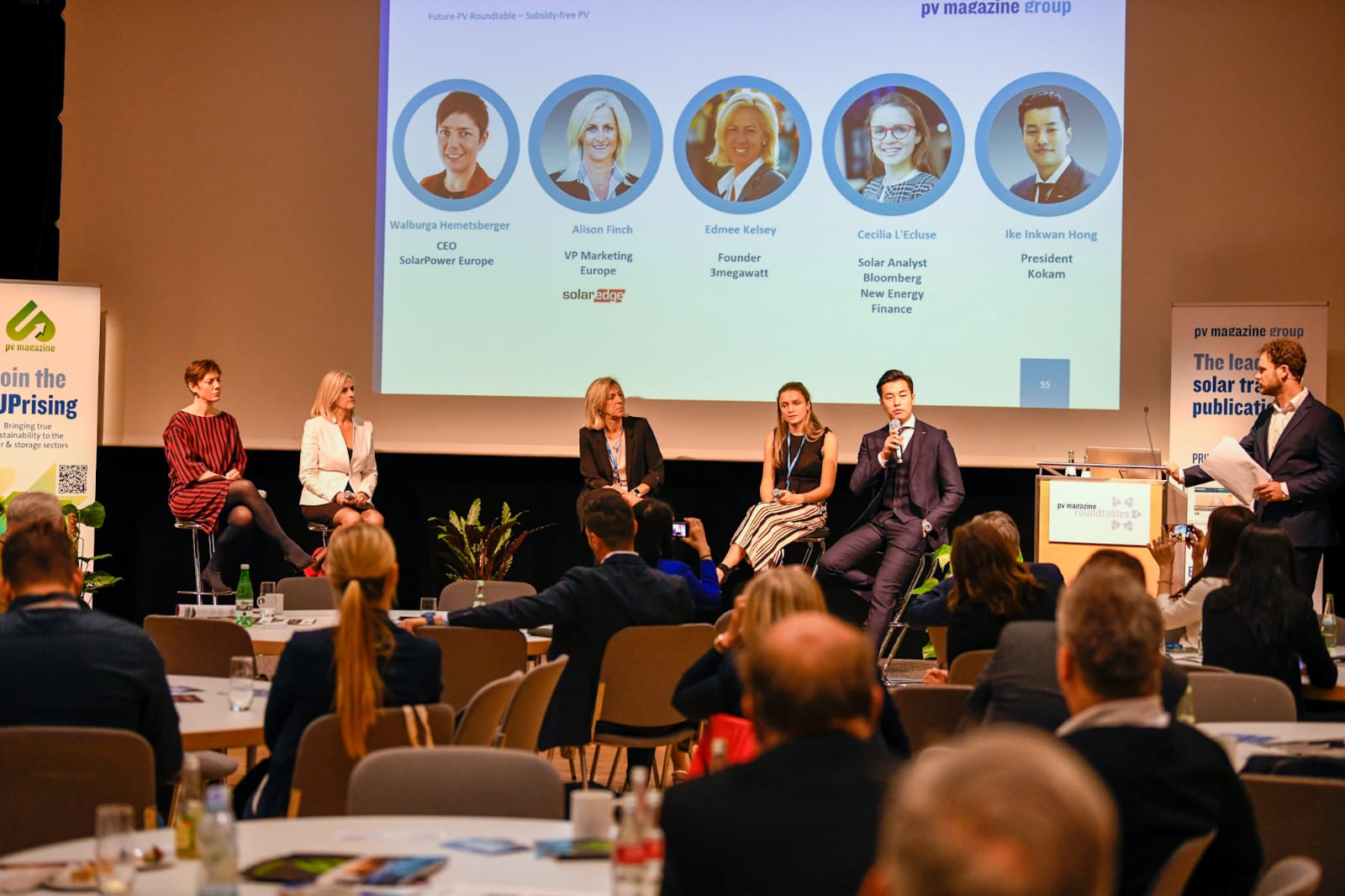
Democratizing energy trading
Making the transition to peer-to-peer energy trading as easy as using eBay or Amazon will engage the public with the energy transition, according to SolarEdge’s Alison Finch, who was speaking at the pv magazine roundtable this afternoon.
Stressing the need to educate a generation on the need for a rapid energy transition, the European marketing VP for the Israeli inverter maker said the advent of virtual power plants and distributed energy generation and storage would take energy trading away from industry specialists.
“I think that’s where the exciting part is,” said Finch, who was speaking as part of the second panel held as part of the morning event, which was notable for being 80% composed of women.
BloombergNEF analyst Cecilia L’Ecluse had earlier given a rosy account of the prospects for the distributed commercial and industrial (C&I) segment in Europe. “We all know the solar market is growing in Europe,” she said, “we expect 5-7 GW yearly in C&I in the next three years.”
It seemed the only member of the panel, moderated by pv magazine gaffer Jonathan Gifford, with problems was Ike Inkwan Hong, president of battery supplier Kokam, which is now part of the SolarEdge group.
Explaining that EV companies are demanding ever lighter batteries whilst storage companies wanted longer lasting products, Hong complained: “Everybody wants a Ferrari – with Hyundai prices!”
This post was amended on 21/05/19 at SolarEdge’s request to indicate Kokam has been acquired by the inverter maker.
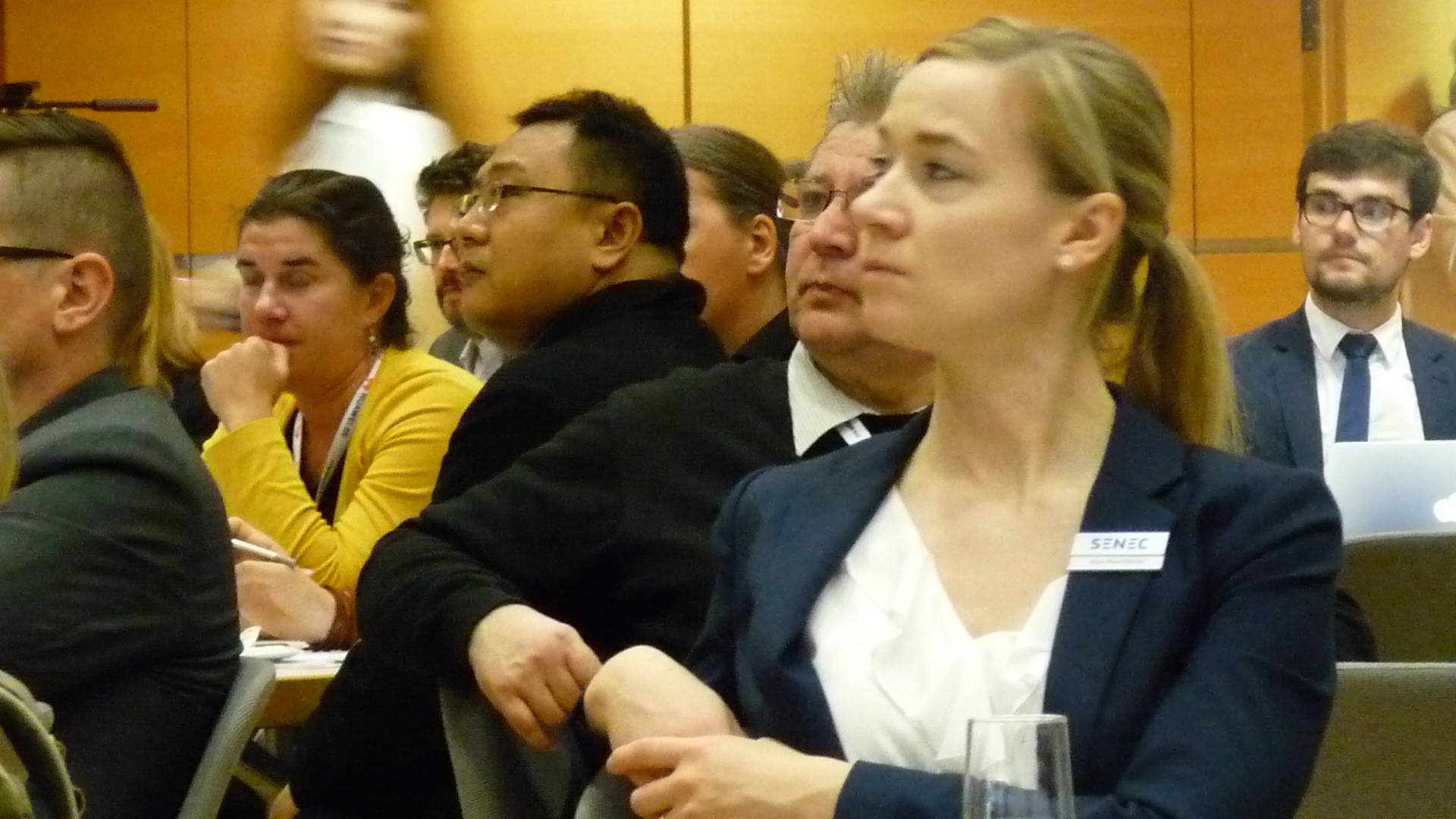
Cutting to the Chase
From 20-cents-per-Watt solar panels to the democratic potential of virtual power plants, the first of two pv magazine roundtable events on the topic of subsidy-free solar had a wide ranging scope.
It was Bloomberg New Energy Finance’s Jenny Chase, a participant in the first of two panel debates in the morning session, who delivered the headline quote.
The manager of BloombergNEF’s Solar Insight service cut through previous comments about “sustainable pricing” of solar panels to state: “If multicrystalline [panel makers] can’t offer a discount on 23 cents per Watt, frankly, they’re going to go bankrupt.”
That comment came moments after Chase had dismissed an earlier prediction by Baywa re Solar Projects CEO Benedikt Ortmann that panel prices would fall to “on or below 20 cents/Watt peak” next year.
“Of course Benedikt wants 20-cent modules,” said Chase, “because he buys solar modules!”
Chase restated BloombergNEF expectations that mono panel prices will stay flat at around $0.23/W before adding her blunt assessment of any manufacturers unable to compete at that level.
ABB: Leveling UP with string sizing tools
Can you imagine a beautiful Italian hillside landscape… that now has to be flattened because solar needs to be installed? This doesn’t sound too sustainable. When asked in consideration of pv magazine’s UP campaign, Leonardi Botti, head of global product management of ABB, explains in a short video statement that planning tools can contribute to a more sustainable solar industry. Among others, ABB came to Intersolar with an updated “string sizer tool.” The webtool designs the electric part of the plant and gives the list of electronic components as output. In the future, it will allow to describe losses in a plant in a more detailed way.
The tool allows the hilly environment to be taken into consideration, so natural landscapes don’t have to be flattened before installation, Botti says.
Creating new business practices for greater sustainability of the #PV industry is a driver to our new #UPcampaign. ABB’s head of product management talks about new software that decreases ecological footprint of projects. The industry is ready for an #UPrising. @ABBgroupnews pic.twitter.com/L7yLRRvs77
— pv magazine (@pvmagazine) May 16, 2019
Of course, there are additional innovations coming from ABB, which offers solutions for every size installation. A new 5 MW central inverter is one of these other innovations. Increasing the size helps reducing the costs, Botti says. And the increasing of size might go up to 10 MW. The limitation will be the transformer, which is connected to the AC output of the inverter. Transformers bigger in size might be too hard to transport to the site of the solar plant, Botti points out.
The discussion on novelties at Intersolar sometimes also reveal new insights into old topics. It is known that ABB collaborates with Tigo for maximizer solutions, and also that the US market is more open for these solutions than the European markets. But pv magazine’s Editor in Chief was surprised to hear how drastic the variation in regional demand is. In the US, approximately 90% of all residential inverters are to be sold with Tigo. Dramatically contrasting with Europe, with just 5 %, according to Botti. The maximizers allow for the optimization on the output of every module, helping in shaded environments.
Side note: the inverter business is not part of the 7-billion dollar deal whereby Hitachi bought 80 % of ABB’s power grid activities last year.
Day 2 of Smarter E: Win an Electric Ride all for Free
Pfalzsolar kicks off another day at Europe’s largest energy transition trade fair with its free giveaway. Visit www.welove.solar to register to win one of 2 all-electric scooters at Intersolar Europe from the pv magazine live sponsor. The drawing takes place tomorrow afternoon – register for the free promotion and schedule a meeting before it’s too late.
Scoot scoot! Are you at @Intersolar Europe? pv magazine live partner #pfalzsolar is giving away two FREE electric scooters. Attendees can register in the competition at https://t.co/pm2NfvLnVE. Register for your chance to win in the #Intersolar drawing today! pic.twitter.com/Neh2OjzeWb
— pv magazine (@pvmagazine) May 16, 2019
A software solution to digitally plan PV projects
You would think that, in the era of digitalization, it should be an easy task to have one piece of software which enables planning of a solar installation from the first mounting system rail to the final inverter grid connection, but you’d be wrong, according to K2’s Katharina David.
Standard software platforms either simulate the mounting structure, calculate ballast and give a list of components needed for installation; or they allow for designing strings and calculate yield prognosis.
Mounting system manufacturer K2 is partnering with inverter maker SolarEdge. K2’s software enables the mechanical design of a PV system. One aspect of the output is the ballast needed to fix a system in place and the list of components an installer needs. The attractive new feature is that the mechanical design can now be directly fed to SolarEdge’s software which, based on the mechanical design, does the electrical planning and yield prognosis.
In future it should also be possible to close the loop in the other direction, in other words to make it possible to feed the electrical calculation results back into the mounting structure calculation software, allowing for better optimization of the whole system.
K2’s David points out few commercial programs are available that can perform what the German manufacturer’s software can now do. By contrast with rival solutions, the K2 software is provided free for customers. It also offers the added value of providing wind load and ballast calculations from a manufacturer which has tested products in the wind tunnel – that is something independent software cannot provide.
At present, K2’s software only works with that provided by SolarEdge but the German business is open to working with other manufacturers and one of SolarEdge’s rivals has already told pv magazine it would be interested in a collaboration.
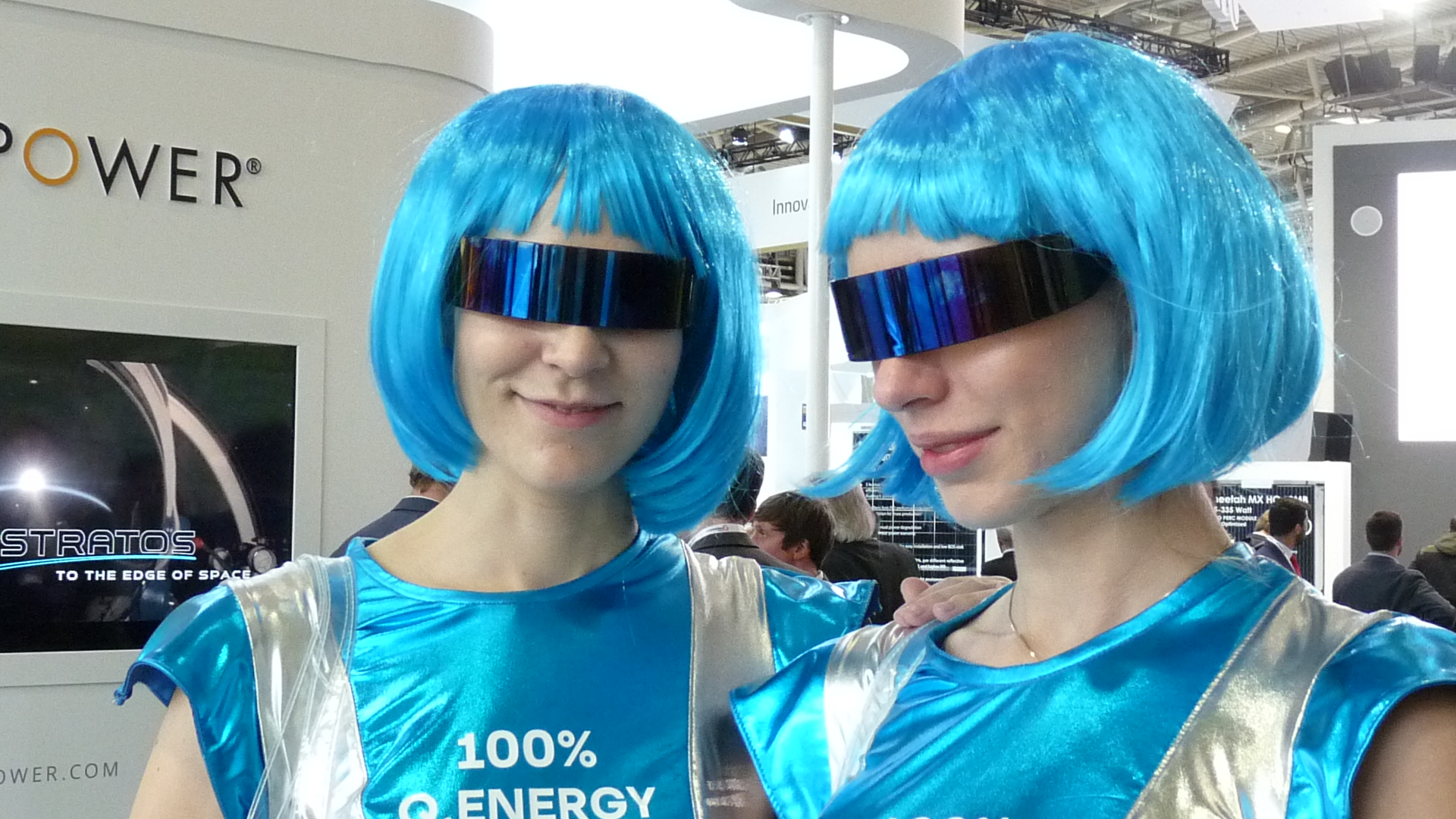
Q why?
We touched briefly yesterday on the different approaches taken by exhibitors at the show, with some still feeling the need to have women – it’s always women – as part of their pitch to attract visitors.
Q Cells is a prime example here, with Kati and Alexander wearing bizarre outfits all day at the Korean manufacturer’s location.
Now, there is a former pv magazine employee working for Q Cells these days and he is present at the show. We think that if enough readers bombard the Q Cells website with requests for equality, Ian Clover should be asked to don one of these outfits for the remainder of the show.
So get writing those emails folks.
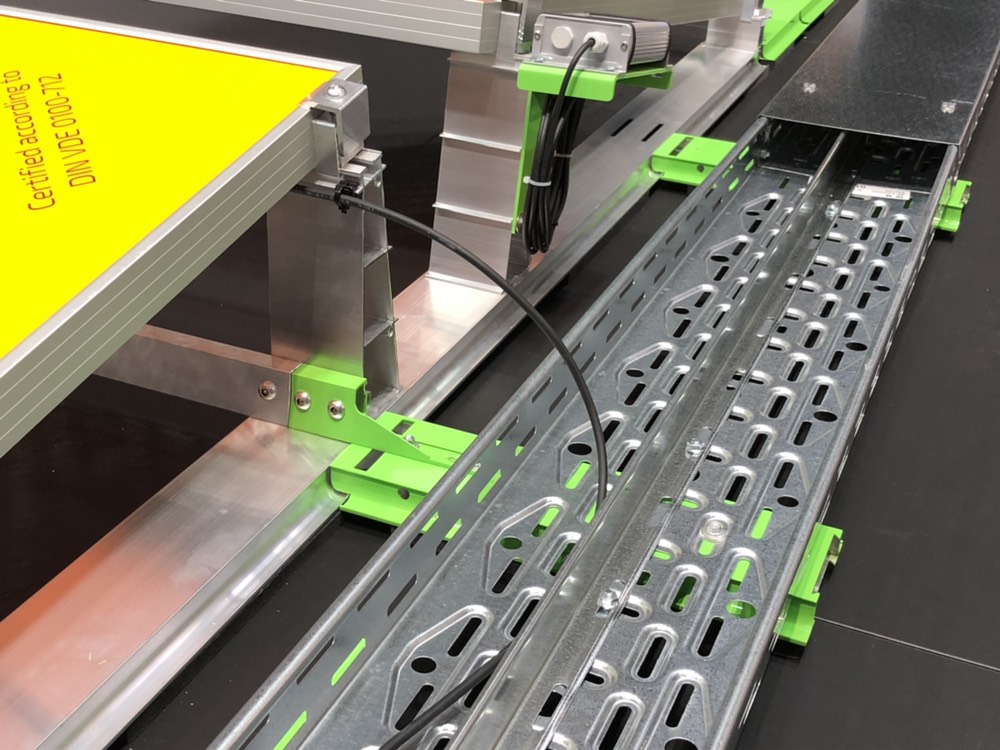
Safety features mount up
Premium Mounting Technologies has added some interesting features to its flat roof mounting system the EVO 2.0 and is showing them off at Intersolar.
For the safety of installers it is now possible to add a cable that can be fixed to rails and runs around a module field. Installers can just attach their safety lines and don’t need to provide any extra measures.
Cable channels can also be added as well as holders to mount instruments such as radiation sensors.
Premium Mounting Technologies’ Tobias Gion told pv magazine the company is offering the features to meet demand for complete solutions from one manufacturer.
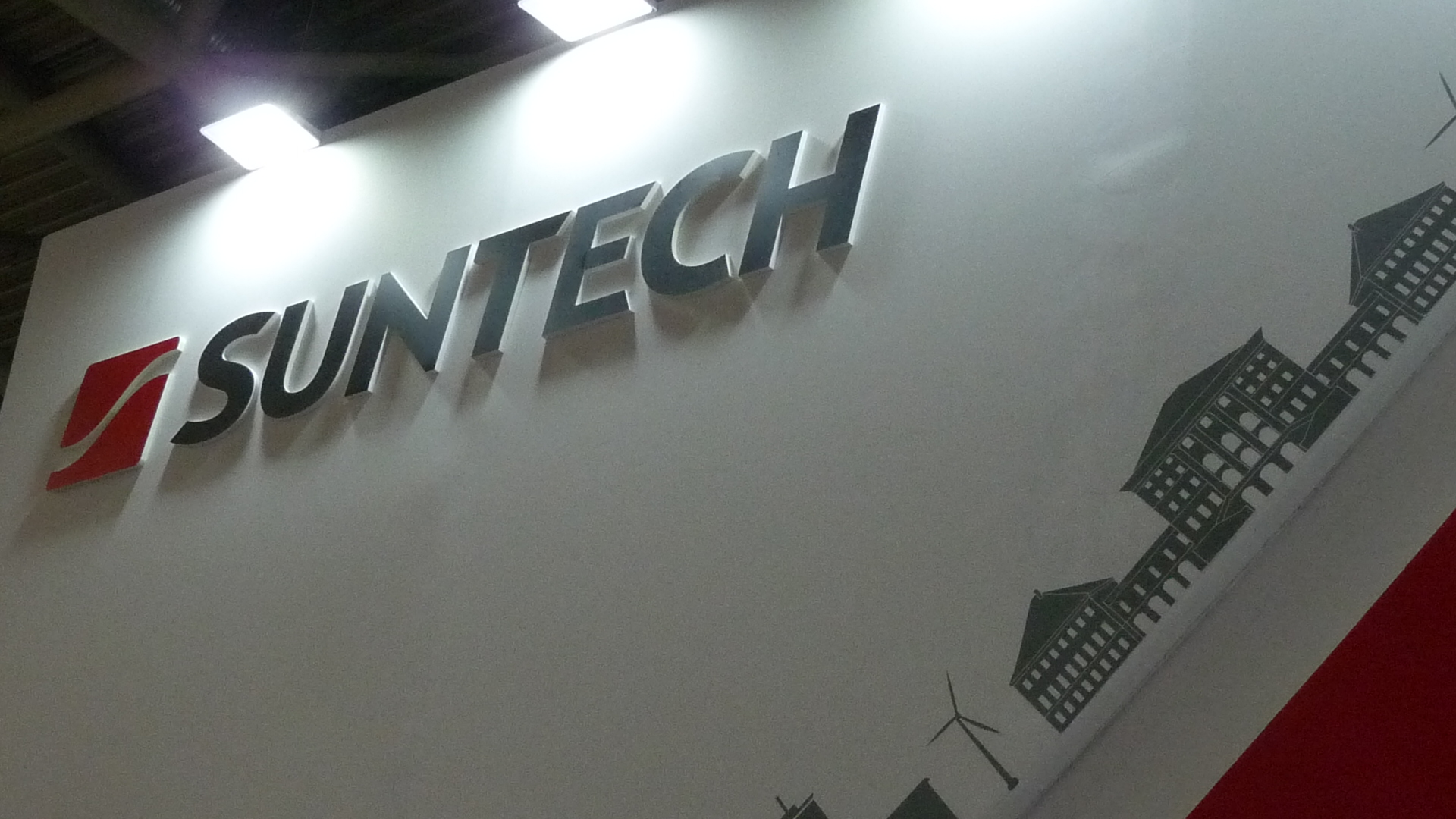
Currency hi-jinks
Yesterday we brought you the thoughts of Vincent Cao, VP for global sales at Suntech, on the burgeoning trade war between the U.S. and China.
With visitors to Intersolar 2019 this morning waking to the news President Trump has banned U.S. firms from dealing with companies deemed to be a threat to national security, we can add Cao’s comments on the plunging value of the Chinese renminbi, which shed more than 2% of its value yesterday.
Referring to the recent escalation of tariffs imposed on Chinese goods by the Trump regime, Cao said: “The Chinese government can fight back. So, one of our weapons is a deprecation of the Chinese RMB. The exchange [rate] for U.S. dollars and the RMB rose from 6.7 to 6.87, which means it’s good for our exports.
“They blame the Chinese government for manipulating the currency and yes, from my point of view it could be looked [at] this way but it’s also one of our solutions for trade with the States. If they want to impose a 25% tax on our imported products, if we lower our currency the consumer can have products at the same price.”
With the Suntech VP stressing it is consumers that will pay the price of the tariff hike, Cao said he expected a deal to ultimately be thrashed out between Washington and Beijing.
“I think so,” he said. “The use of the trade war, it’s just a kind of weapon used by Trump.”
Regarding the latest, apparently failed round of talks, he added: “It’s not a result, it’s just talks. The result will be compromise between China and the U.S. So I think they will find a solution.”
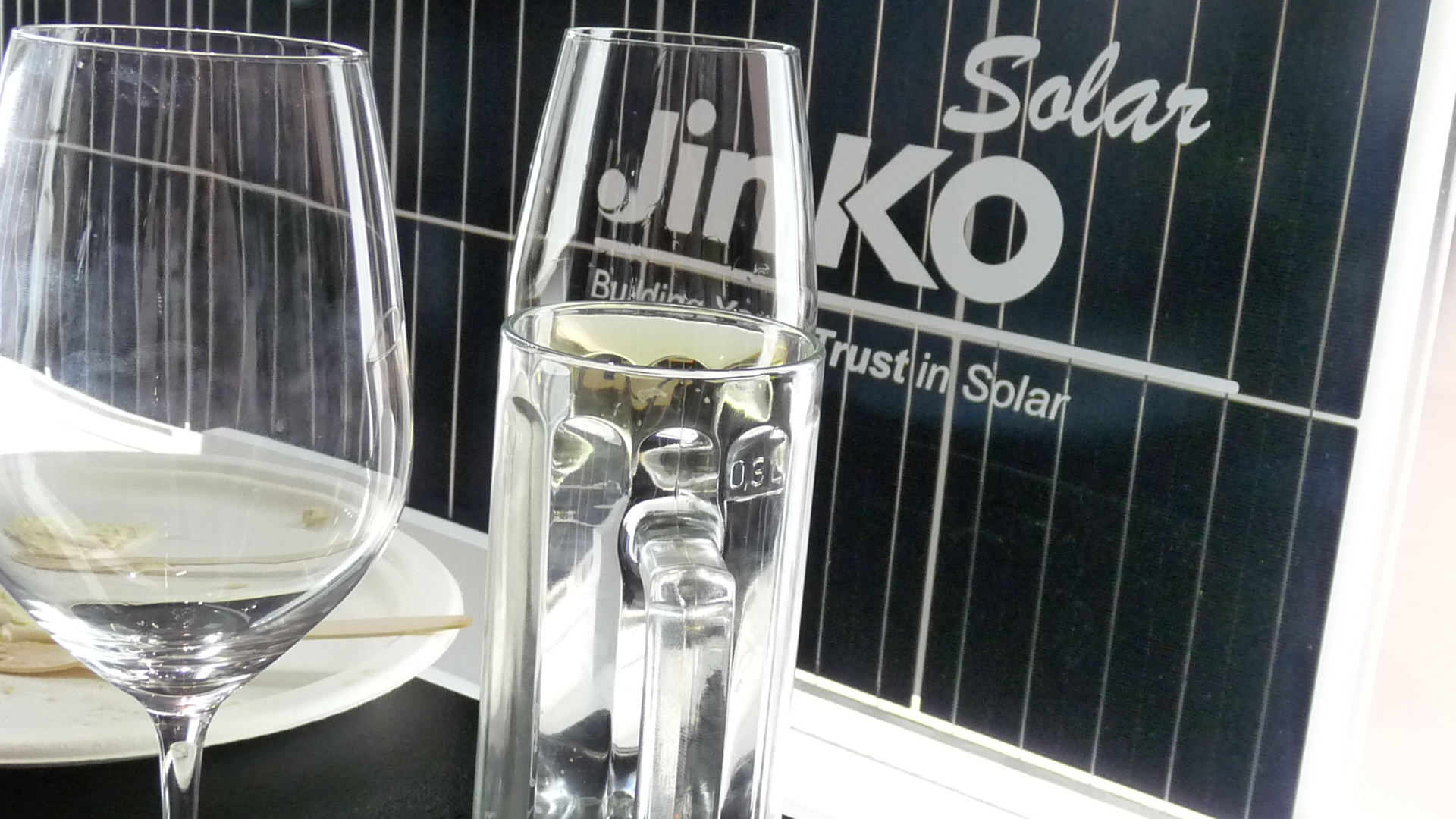
The morning after
Good mornin’ folks and welcome to Day 2 of pv magazine live.
I was up an at ’em this morning, bright-eyed, bushy-tailed and more than a little smug after leaving the Intersolar Europe free party circuit at a (reasonably) sober hour.
As for my colleagues, who knows?
The last I saw of them they had departed the Jinko Solar launch party for the Swan Bifacial HC just as the sound of brooms on broken glass signaled the winding down of proceedings.
Chief party spotter appeared to be Marian Willuhn who led the pv mag posse on to a raucous event that appeared to be conducted under the auspices of the German equivalent of Barry’s Mobile Disco at the SOLLIS Solargroßhandel stand.
Amid the party hats and cocktails, I was forced to depart upon hearing an horrendous desecration of a Neil Diamond classic and a tune that appeared to be about Niki Lauda’s mother. I think something may have been lost in translation there.
Anyhoo, hangovers at the ready, we’ll be back on the serious stuff forthwith and have not one but two pv magazine roundtables to look forward to today. Stay tuned.
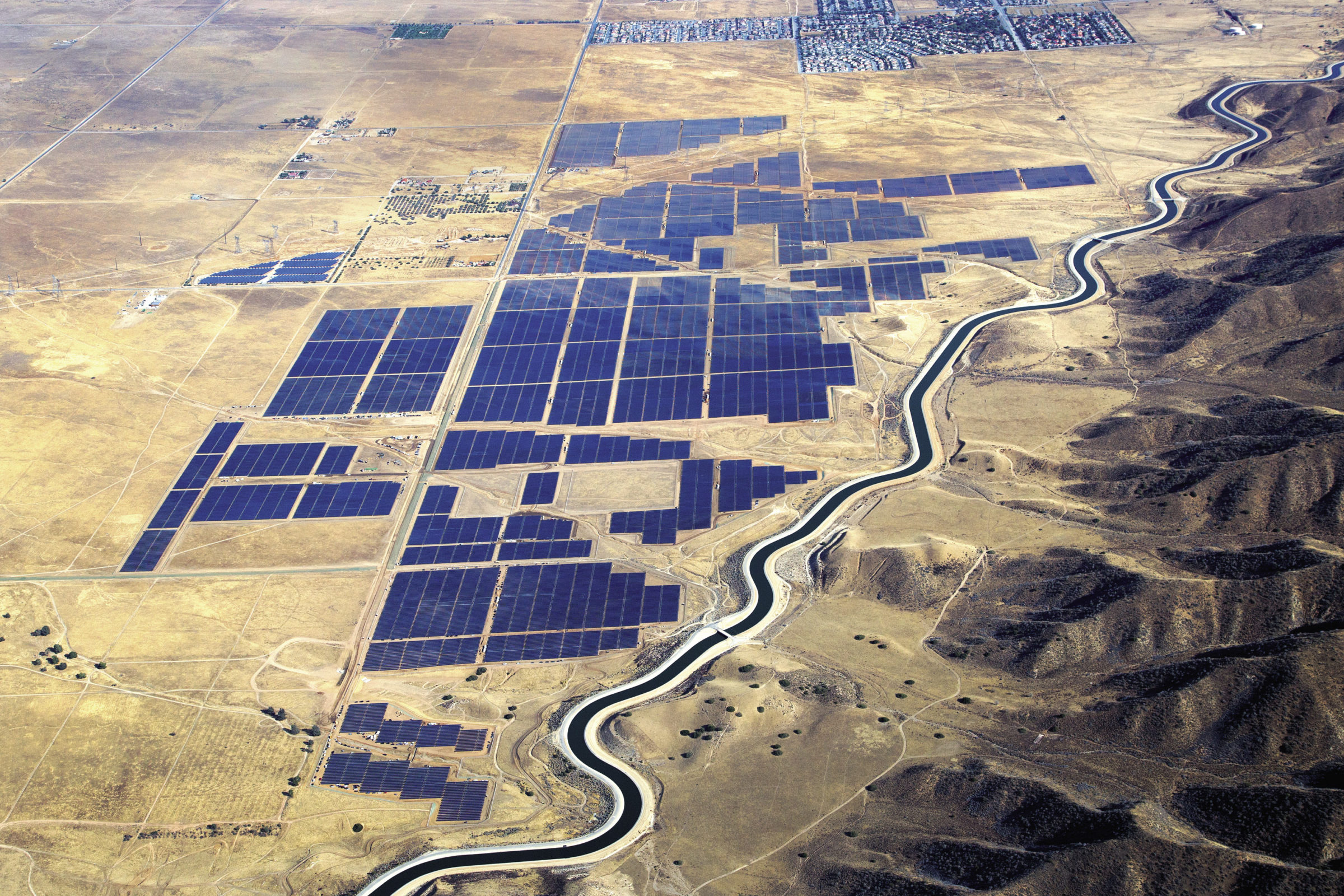
JinkoSolar on why it has chosen a cradle to cradle path
Last night, JinkoSolar's new Swan Bifacial HC module was announced winner of the Innovation Award at Intersolar Europe 2019. In addition to its impressive technological features, such as the clear tedlar-based backsheet from DuPont, the module is also in the process of achieving cradle to cradle certification – a pioneering initiative aimed at designing products in an environmentally and socially positive way.
In 2017, JinkoSolar was the first Chinese company, and the second solar company, to achieve the certification for its Eagle Series modules. pv magazine caught up with Radu Roman, Product & Business Development Manager – Europe to talk about the process, why it is so important to the company, and what’s in store for the future.
A few eggs in a few baskets
Phono Solar operates 2 GW of module manufacturing capacity, having successfully bought a factory online in Turkey working alongside a local partner.
The company’s executive vice president Aaron Wu revealed yesterday that the company is now seeking to emulate this expansion in the United States, and is at the stage of talking with several local partners about the potential for this, as well as citing one contract with a major U.S. utility for more than 200 MW of modules.
Wu also explained that Phono Solar weighs up its opportunities based on long-term planning, and is not currently considering further production expansions in China, looking to avoid issues of oversupply and international trade.
He went on to give further confirmation of Europe’s solar comeback, stating that Phono Solar has more than doubled its shipments to the Benelux region in the past year, alongside strong sales in France, Italy and other regions on the continent.
On the technology side, Wu is confident on the prospects for Phono’s metal wrap through (MWT) technology. He notes that multi MW projects featuring Phono’s MWT modules have been realized in several markets, with Germany and Japan both particularly accepting of the technology.
While he also confirmed that the share of multicrystalline products is continuing on its downward trend, possibly reaching as low 20% in the next couple of years, he says that in certain markets and projects Phono still sees demand for such technology.
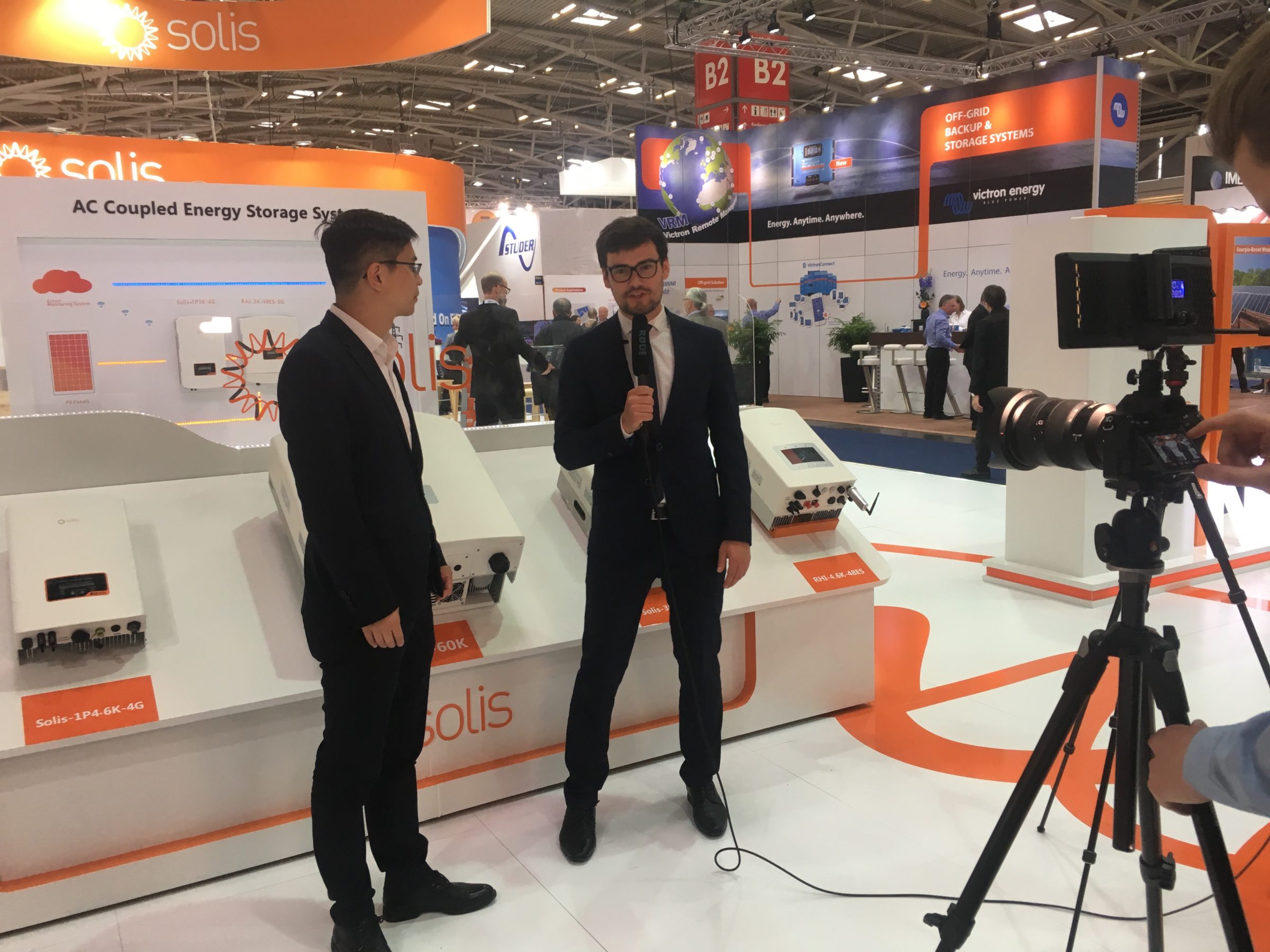
European positioning
Jimmy Wang, president of Ginlong (Solis) took the time to do a video interview with pv magazine editor, Marian Willuhn on the first day of Intersolar Europe.
Wang talked through the inverter manufacturer's latest suite of products, and its position in the European market. Solis has added its 4G technology platform, its fourth generation product offering.
The company boasts a solid global profile and is excited to further tap into the growing European markets. The company has also recently been publicity listed at the Shenzen stock exchange. According to Wang, the new capital is a welcome feat for Ginlong's planned growth.
Watch out for footage of the video later.

